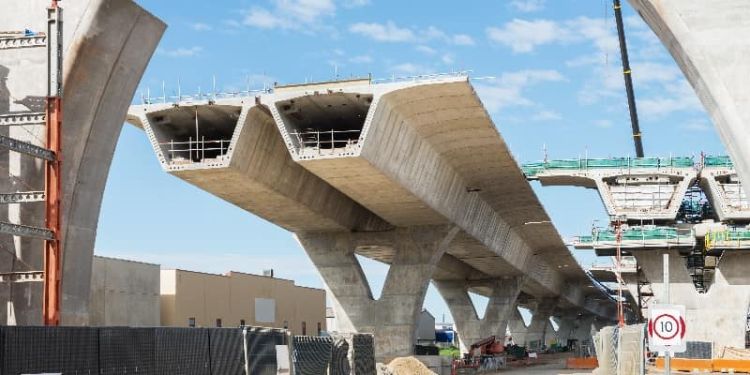The Essential Role of Concrete Structure in Structural Integrity and Durability
When it involves building a residential or commercial property, the foundation is more crucial than you might believe. Concrete foundations provide unparalleled toughness and durability, guaranteeing your framework can stand up to different environmental obstacles. Without a solid base, you risk prospective issues like changing or cracking, which can jeopardize security and value. Recognizing the nuances of concrete foundations could be the secret to maintaining your financial investment for several years to find. What should you consider following?
Comprehending the Relevance of Concrete Foundations
Concrete foundations are vital to the general stability of any type of structure, as they provide the vital assistance needed to stand up to numerous lots and environmental problems. When you consider building a home or a commercial area, the foundation is the very first point you should take into consideration. It acts as an obstacle against wetness, securing your building from water damage. A well-placed concrete structure likewise stops settling and shifting, which can bring about fractures in walls and floorings. You'll intend to guarantee that the foundation is properly designed and reinforced, as this impacts the longevity of your structure. Additionally, a solid structure can improve energy efficiency by lowering air leakages. Bear in mind, neglecting the relevance of a concrete structure can result in pricey repair services down the line. So, purchasing a quality structure upfront is essential for the stability and toughness of your framework.
Advantages of Concrete Foundations for Architectural Stability
While many aspects contribute to a structure's architectural honesty, concrete foundations supply unmatched resilience and stamina. You'll value that concrete can endure severe weather, resisting both moisture and temperature level changes. This resilience indicates your structure is much less most likely to experience breaking or shifting in time, which can jeopardize its safety.Additionally, concrete's fundamental weight provides a solid base, avoiding activity throughout natural occasions like quakes or floodings. When you pick a concrete structure, you're additionally selecting low upkeep; unlike timber, it will not rot or attract parasites, saving you time and cash in repairs.Moreover, concrete's fire resistance uses added safety and security, guaranteeing your framework can withstand high temperatures without considerable damage. On the whole, purchasing a concrete foundation suggests you're focusing on the long-lasting security and honesty of your structure, making it a smart selection for any construction project.
Common Sorts Of Concrete Foundations
When it concerns constructing structures, understanding the usual kinds of concrete foundations can aid you make notified options for your project. One of the most common kinds consist of slab-on-grade, crawl area, and full basement foundations.A slab-on-grade foundation is a basic, affordable option, where a thick concrete slab is put directly on the ground. This type functions well in warm environments, as it minimizes warmth loss.Crawl area foundations raise the home somewhat over ground, permitting air flow and accessibility to pipes and electric systems. This layout can help protect against wetness issues.Full basement foundations offer additional living or storage area while supplying superb architectural assistance. They require more excavation and are generally made use of in cooler environments to avoid frost heave.
Elements to Consider When Designing a Concrete Foundation

Finest Practices for Setting Up Concrete Foundations
When you're installing a concrete structure, proper site preparation is necessary to guarantee stability (West Coast General Engineering industrial concrete Rancho Cucamonga). You'll also need to understand reinforcement techniques to improve toughness and toughness. Don't ignore the treating process, as it plays a fundamental function in achieving a solid foundation.
Website Preparation Importance
Although it may appear straightforward, correct website prep work is crucial for guaranteeing a solid and resilient concrete foundation. Start by clearing the area of any debris, plant life, or organic material that could endanger the foundation's integrity. Next off, analyze the soil kind and compaction; you could need to excavate or add products to develop a steady base. Level the ground to guarantee even weight distribution and prevent working out problems later on. Installing correct drainage systems is likewise vital to protect against water buildup, which can deteriorate the foundation in time. Ultimately, define the foundation's dimensions accurately to assist the pouring process. By adhering to these steps, you'll establish the stage for a successful concrete foundation that stands the test of time.
Support Techniques Described
As soon as the site is properly prepared, the next action in assuring a durable concrete foundation entails executing reliable reinforcement methods. You must start by utilizing steel rebar, which provides tensile strength and aids avoid breaking. Lay the rebar in a grid pattern, ensuring it rises making use of spacers to keep correct coverage. Furthermore, think about utilizing cable mesh for added support, particularly in locations subject to heavy loads. Don't fail to remember to tie the rebar junctions safely with cord. For larger foundations, fiber reinforcement can improve longevity, decreasing the danger of contraction cracks. Constantly adhere to neighborhood building codes and guidelines to make certain conformity. By applying these support methods, you'll considerably Discover More Here improve your structure's toughness and longevity, laying a solid groundwork for your framework.
Curing Process Basics
To assure your concrete structure cures appropriately, it is very important to maintain appropriate wetness and temperature level problems immediately after pouring. Beginning by covering the surface area with a wet cloth or plastic sheet to keep wetness. This keeps the concrete moisturized, preventing splits and making sure strength. You ought to also keep an eye on the temperature level; perfect curing conditions are in between 50 ° F and 90 ° F. If it's too hot, haze the surface routinely to stop quick dissipation. For cold weather condition, take into consideration using shielding blankets to keep heat. Go for a treating duration of at least seven days, as this is crucial for ideal strength growth. By complying with these ideal techniques, you'll boost your foundation's longevity and long life, ensuring structural honesty for many years ahead.
Maintenance of Concrete Structures for Longevity
To keep your concrete structure solid and enduring, normal inspections are vital. You must also ensure reliable drainage options are navigate to this website in location to avoid water damage. If you find any type of fractures, addressing them promptly will save you from bigger problems down the line.

Normal Evaluations and Evaluations
While normal inspections and evaluations might look like a chore, they're necessary for preserving the honesty of your concrete foundation. By routinely inspecting for cracks, shifts, or indications of wear, you can capture prospective issues prior to they intensify right into costly repair services. Search for any kind of water merging around the foundation or unusual settling, as these can signal underlying problems. It's additionally wise to check any adjustments in your home's framework, like doors that stick or home windows that do not open smoothly. Keeping a record of your evaluations assists track modifications in time, permitting proactive upkeep. Ultimately, these assessments assure your structure remains steady, supporting the long life and security of your whole framework. Don't overlook this important aspect of homeownership!
Efficient Water Drainage Solutions
Regular evaluations can expose concerns like drainage issues that may compromise your concrete foundation's stability. To avoid water accumulation, guarantee your gutters and downspouts direct water away from the structure. Installing French drains pipes can efficiently redirect surface and groundwater, reducing pressure on your foundation wall surfaces. In addition, grading the soil around your home assists ensure that water moves away, rather than pooling near your foundation.Consider making use of sump pumps in locations prone to flooding, as they proactively eliminate excess water. On a regular basis check for clogs in drain systems and clear them quickly. You'll secure your foundation's integrity and durability by taking these proactive steps. Remember, effective drainage remedies are important for keeping a strong, long lasting concrete foundation.
Motivate Crack Repairs
When you notice fractures in your concrete structure, addressing them promptly is important for preserving its durability. Tiny cracks can promptly progress into bigger problems, compromising the architectural stability of your home. On a regular basis evaluate your foundation for indications of damage, such as straight or vertical cracks. If you spot any, don't wait-- fix them right away. You can use epoxy injections or concrete patching compounds, which are efficient for securing cracks. Always comply with the maker's guidelines and think about consulting an expert for significant damage. Remember, prompt repair work not only boost your foundation's durability however likewise save you money in the future by stopping a lot more considerable repair services down the line. Stay proactive, and your structure will certainly stay strong and protected.
Addressing Common Concerns With Concrete Foundations
Concrete foundations can deal with various problems over time, making it useful reference essential to recognize and address them quickly. Among one of the most usual issues is fracturing, which can occur due to temperature variations or resolving soil. If you see splits, it's important to assess their dimension and depth; tiny fractures can frequently be sealed, while larger ones might call for professional evaluation.Water invasion is one more major problem. Excess dampness can bring about mold growth and structural degeneration. Warranty appropriate drainage around your foundation to minimize this danger. Additionally, seek indicators of shifting or bowing wall surfaces, as this can show underlying issues with your structure's stability.Regular assessments are fundamental to capture these problems early. If you detect any concerning indications, do not hesitate to consult a structure expert. By remaining aggressive, you can keep the stability and long life of your concrete foundation, assuring your home remains secure and safe and secure.
Often Asked Concerns
Just How Does Soil Kind Affect Concrete Foundation Performance?
Dirt kind significantly impacts concrete structure performance. If you've obtained expansive clay, for instance, it can trigger moving and cracking. Sandy soil may cause resolving. Comprehending your dirt assists ensure a secure foundation.
Can Concrete Foundations Be Repaired if Harmed?
Yes, you can fix damaged concrete foundations. Depending upon the degree of the damage, techniques like epoxy injection or piece jacking can bring back security. It's finest to consult a specialist for efficient solutions.
What Is the Typical Lifespan of a Concrete Foundation?
A concrete structure normally lasts 30 to 100 years, depending on elements like soil conditions, climate, and maintenance. You'll want to keep an eye on it to guarantee it remains in good form throughout its life-span.
Are There Alternative Materials to Concrete for Foundations?
Yes, there are options to concrete for structures, like steel, timber, and even recycled materials. Each choice has special advantages and disadvantages, so you must consider your task's certain demands when selecting the ideal material.
Just How Does Environment Impact Concrete Foundation Durability?
Climate substantially influences concrete structure durability (West Coast General Engineering commercial concrete). Extreme temperatures, dampness, and freeze-thaw cycles can damage the material, bring about cracks and structural problems. You should consider regional environment conditions when preparing your structure to ensure long-term performance